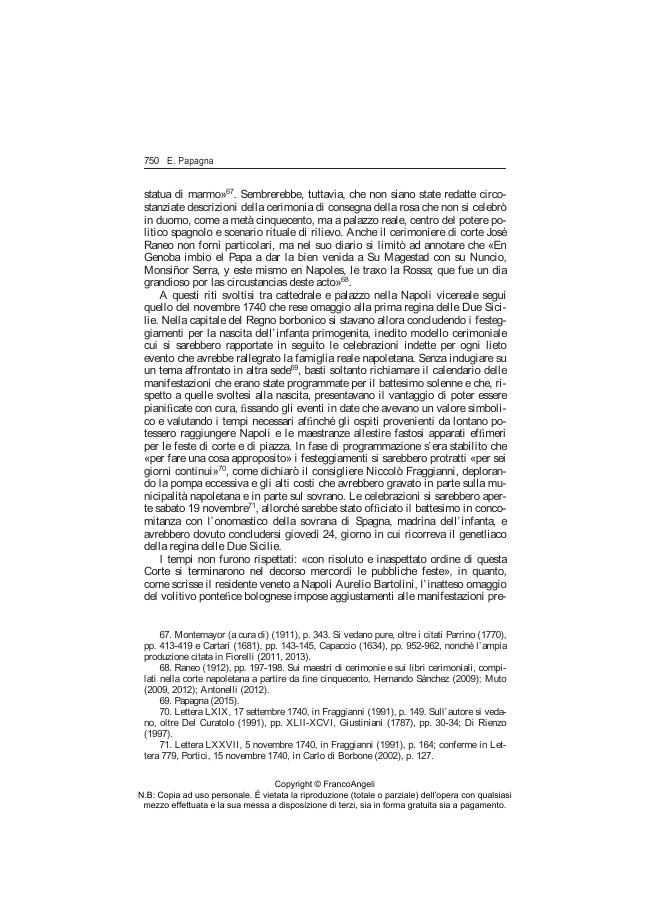Il dono pontificio della Rosa d'Oro : un antico rituale nella corte napoletana di Carlo di Borbone
735-765 p.
L'autrice illustra preliminarmente il complesso simbolismo dell'antico rito della rosa che era indicativo del rapporto gerarchico tra potere spirituale e temporale e che in età moderna era scandito in due fasi: l'una di unzione e benedizione del fiore per mano del pontefice; l'altra di attribuzione del prestigioso omaggio a un autorevole sostenitore della religione e della Chiesa. Si sofferma sul secondo momento cerimoniale e analizza il conferimento del dono inviato da Benedetto XIV alla prima regina delle Due Sicilie, Maria Amalia di Sassonia, con l'auspicio di favorire, per suo tramite, i rapporti tra Roma e Napoli.
La cerimonia non si svolse pubblicamente, ma in spazi riservati e in presenza di un numero ristretto di partecipanti, divergendo da un modello consolidato che, nelle intenzioni di cerimonieri e trattatisti, avrebbe dovuto rappresentare la genesi sacrale del potere regio di fronte ai sudditi esultanti. L'evento napoletano, in linea con analoghe tendenze emergenti in altre corti europee, denotava una trasformazione della cultura cortigiana, volta a separare progressivamente la sfera pubblica dalla privata e a garantire ai regnanti uno spazio intimo ove estrinsecare sentimenti ed emozioni personali. [Testo dell'editore].
In the introduction the author illustrates the complex symbolism of the ancient rite of the rose, indicative of the hierarchical relationship between spiritual and temporal power. She notes that in modern times the rite was divided into two phases: one was characterized by the anointing and blessing of the flower by the pontiff; the other consisted in conferring the prestigious tribute to an authoritative supporter of religion and the Church. The author focuses on the second ceremonial moment and analyzes the conferment of the gift sent by Benedict XIV to the first queen of the Two Sicilies, Maria Amalia of Saxony, with the hope of favoring, through her, the relations between Rome and Naples.
The ceremony did not take place publicly, but in reserved spaces and in the presence of a few participants. Therefore, it diverged from a consolidated model intended to represent the sacred genesis of the royal power in front of the exultant subjects. The Neapolitan event denoted a transformation of courtly culture that was emerging in other European courts and that aimed to progressively separate the public sphere from the private and to guarantee to the rulers an intimate space where to express personal feelings and emotions. [Publisher's text].
Is part of
Società e storia : 166, 4, 2019-
Articles from the same issue (available individually)
-
Information
ISSN: 1972-5515
KEYWORDS
- Cerimoniale, rosa d'oro, Regno di Napoli, XVIII secolo, corte borbonica, Maria Amalia di Sassonia
- Ceremonial, Golden Rose, Kingdom of Naples, 18th century, Bourbon Court, Maria Amalia of Saxony



